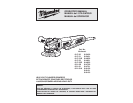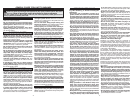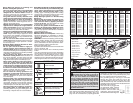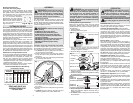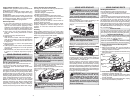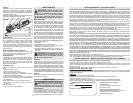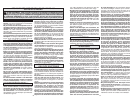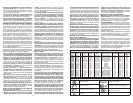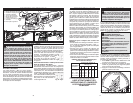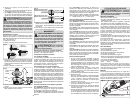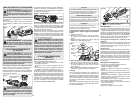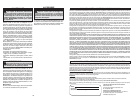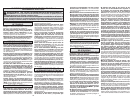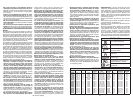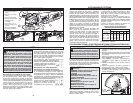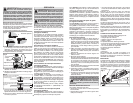
8
9
WARNING To reduce the risk of injury,
the operator should be instructed in the
use, care and protection of grinding wheels.
Fig. 5
For best result use only this portion of disc
Hold at a
Hold at a
5° to 15° angle
5° to 15° angle
USING GRINDING WHEELS
Trigger Switch Operation (some models)
To start the tool, grasp the handle and side handle
fi rmly and pull the trigger.
To stop the tool, release the trigger. Make sure
the tool comes to a complete stop before laying
the tool down.
To lock-on the switch (some models), start the tool
and push in the lock-on button. To stop the tool, pull
and release the trigger. Make sure the tool comes
to a complete stop before laying it down.
General Operation
1. If you have just installed an accessory or are
beginning a period of work, test it by letting it
spin for one minute before applying it to the
workpiece. Out-of-balance or damaged acces-
sories can mar workpiece, damage the tool, and
cause stress that may cause accessory failure.
2. Use a clamp, vise or other practical means to
hold your work, freeing both hands to control
the tool.
3. Hold tool securely with both hands.
4. Start the tool.
Note: On some models, if the tool is plugged in
when the tool switch is in the "ON" position, the
tool will not run. Turn the tool off, then back on
to begin work.
5. Allow accessory to come to full speed before
beginning work.
6. Control pressure and surface contact between
accessory and workpiece. Too much pressure
slows speed.
7. When fi nished, turn off the tool and make sure
it comes to a complete stop before laying it
down.
Fig. 6
WARNING A Type "1" guard must be
installed when using a cut-off wheel to
provide maximum protection for the operator
if the wheel should break.
WARNING Using the face of a Cut-Off
Wheel (as in grinding) will cause the
Wheel to crack and break, resulting in serious
personal injury.
USING CUT-OFF WHEELS
Type "1" Cut-Off Wheels are suited for small cut-off
and shallow notching operations only.
When using a cut-off wheel, hold the tool as shown,
using only the edge of the wheel.
Fig. 7
WARNING Everyone in the area must
wear protective clothing and safety
goggles or face shields. Fatigued wires and
residue will fl y off the brush with considerable
force, causing potential for serious injury.
USING WIRE BRUSHES
Wire brushes are useful for removing rust, scale,
burrs, weld slag, etc.
Always install wire cup brushes according to the
accessory manufacterer’s instructions.
WARNING Because the wires on wire
wheel brushes are directed towards the
operator, a guard must be used to protect the
operator when fatigued wires break.
Wire
Wheel
Brush
Fig. 8
Guard
When using a wire wheel brush, install guard ac-
cording to "Installing/Removing Accessories".
Grinding Wheel Selection
Use grinding wheels, and accessories that are:
• correct size as written on tool’s nameplate.
• rated at or above the RPM listed on the tool’s
nameplate.
• correct accessory, wheel type and grit for the job.
Grinding is the cutting action of thousands of abra-
sive grains on the face of a grinding wheel. When
grinding metals such as steel and iron, choose an
aluminum oxide grinding wheel. Select a silicon
carbide grinding wheel for stone and concrete. Use
cotton reinforced wheels for non-ferrous metals.
Type 27 Reinforced 1/8" thick or less Cut-Off
Wheels are suited for small cut-off and shallow
notching operations only. Always handle wheels
carefully to avoid damage. Before installing any
wheel, always inspect it for cracks. If wheel is
cracked, discard it to prevent others from using it.
WARNING Never exceed Maximum
Safe Operating Speed of brush. Do not
use a damaged brush or one that is func-
tioning improperly (throwing wires, out-of-
balance, etc.). These conditions increase
the possibility of further brush failure and
possible injury. Discard and replace damaged
brushes immediately.
Test wheel for balance and loose or damaged wires
by letting it spin for one minute before applying it
to the workpiece. During this time, no one should
stand in front of or in line with it.
Control pressure and surface contact between
wheel and workpiece. Too much pressure causes
over-bending of wires and heat build-up causing
premature wire breaking, rapid dulling and reduced
brush life. Instead of more pressure, try a wire wheel
with more aggressive cutting action (increased wire
size, decreased wire length or different brush type
(knot type vs.crimped wire type).
Aluminum Oxide
For fast cutting, general purpose discs for most metal
jobs. Best for cold-rolled steel, stainless steel or met-
als requiring tough, fast cutting, long lasting abrasives.
Aluminum Zirconia Bi-Cut
Unique grit pattern is arranged in clusters for faster
stock removal and cleaning. Ideal for removing paint
from cars, boats, etc. without clogging.
Ceramic
Lasts up to 3 times longer than Aluminum Oxide
Discs. For general metal working. Ideal for tough jobs.
Sanding Disc Selection
Use sanding discs and accessories that are:
• correct size as written on tool’s nameplate.
• rated at or above the RPM listed on the tool’s
nameplate.
• correct accessory, wheel type and grit for the job.
Refer to the table below to select the correct type
of sanding disc for your job. Generally, use 24 or
36 grit for heavy stock removal; 50, 60, or 80 grit
for medium stock removal and 120 grit for fi nishing.
Always begin with a coarse grit, using successively
fi ner grits to obtain the desired fi nish. See your
MILWAUKEE Electric Tool Catalog for a complete
list of sanding discs.
USING SANDING DISCS
Installing Backing Pad and Sanding Discs
1. Unplug the tool.
2. Wipe the accessories, disc nut and spindle to
remove dust and debris. Inspect the parts for
damage. Replace if needed.
3. Slip backing pad onto spindle with fl at side away
from gear case.
Fig. 9
Spindle
Backing
pad
Disc nut
Sanding
disc
4. Place sanding disc on backing pad and secure
assembly to spindle with disc nut.
5. To tighten, press the spindle lock button while
turning disc nut clockwise with the spanner
wrench provided.
6. To remove backing pad and sanding disc, unplug
the tool and reverse the procedure.
Wire Cup Brush
Care of Grinding & Cut-Off Wheels
Grinding/cut-off wheels should be protected from:
• wetness and extreme humidity
• any type of solvent
• extreme changes in temperature
• dropping and bumping
Grinding and cut-off wheels should be stored:
• in an organized way so wheels can be removed
without disturbing or damaging other wheels
• with their safety information
Grinding and cut-off wheels should NOT be
dropped, rolled or bumped.
Discard wheels that have been dropped, rolled,
bumped, subjected to extreme changes in tem-
perature, or come into contact with solvents or
wetness.
Grinding
When grinding, hold tool at a 5
o
to 15
o
angle, using
constant pressure for a uniform fi nish. Too great an
angle causes concentrated pressure on small areas
which may gouge or burn work surface.



